Introduction
Organizations often struggle with balancing quickly responding to changing business requirements and available technologies and ensuring consistent and reliable service delivery that aligns with and supports their overall business strategy. Over my 18+ years emersed in the world of IT Governance (ITG) and IT Service Management (ITSM) I have seen significant changes in the way we identify, define, implement and manage services. The introduction of the ‘Agile Manifesto’ and the related Principles in the early 2000s seriously challenged the traditional SDLC methods employed. However, my experience is that ‘Agile’ is often applied at the expense of, instead of in conjunction with Strategic Thinking, resulting in less than optimal products, rework, and in the end, extra costs, delayed timeframes and unsatisfied customers, the exact things that Agile was supposed to address. In this article I’ll discuss the balancing act that enables organizations to be ‘Agile’ and ‘Strategic’ at the same time.
Now more than ever, the concept of “Less is More” resonates with people and organizations. Decision makers are inundated with more information through more media than at any other time in history. Consequently, we’ve all been asked to give the “elevator speech” version of a proposal or concept. A Google search for ‘crafting the perfect elevator pitch’ resulted in over 590K results, providing all kinds of examples and guidance. This is obviously a significant topic today.
Agile practices call for the ability to receive and act on new and changing business requirements with little or no delay.
 The focus sometimes prioritizes Speed over Completeness. Lastly, I find more and more organizations looking to achieve the “One Sheet Strategic Plan” to provide guidance on the organization’s priorities and direction.
The focus sometimes prioritizes Speed over Completeness. Lastly, I find more and more organizations looking to achieve the “One Sheet Strategic Plan” to provide guidance on the organization’s priorities and direction.
I’m not criticizing any one of these concepts.
I fully understand the need to be succinct, direct, and to the point. I also understand the need to move quickly to bring value to the organization faster and before the environment changes. What I am suggesting is if we start and stop at the Elevator Speech level of detail, if we implement Agile in a vacuum without a strong framework around it, or if we stop with the One Sheet Strategic Plan without additional guidance supporting the items on the page, we leave too many details open to interpretation and create an environment where complex Strategies and/or Services are not optimized.
Setting the Stage
So, what are we experiencing in the real world? I think we can all relate to the following scenario: an initiative that has been chartered quickly to develop or enhance a product or service. We are pressured to kick off the initiative and only have a high level of definition of what is to be developed. We start working towards our understanding of that definition using Agile techniques and are making good progress. However, before we get to a Minimally Viable Product for release, we get more information and our definition of done changes. We reactively change our design, potentially requiring us to undo some work that has already been completed and start working towards our new understanding.

Over the course of developing a significant service, there is the potential to change course multiple times before we finally achieve a production ready product for release. These course changes may be necessary to ensure that the process being developed is lean, optimized and takes advantage of available technologies; ability to integrate with a previously undisclosed product that is also being developed; or, to incorporate requirements for another new, related product or service. If this was a train trip, it might look like this.
What are our alternatives? We could wait for all the requirements to be understood, a Lean engagement be completed to streamline the process and include automation, and all related products and services to be fully fleshed out before we start. However, experience teaches us that Stakeholders do not have the patience for that level of planning before seeing progress.
The Balancing Act
This is where the “Balancing Act” comes in. We need to provide consistent and reliable services while simultaneously being responsive to change. We need to achieve the appropriate levels of security and quality while bringing products to market quickly.
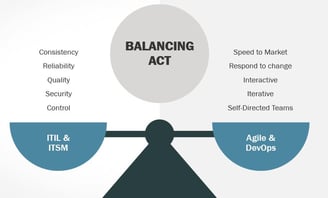 This discussion about Balance is happening in many organizations today. For instance, a recent Harvard Business Review article Have We Taken Agile Too Far? by Colin Bryar and Bill Carr discusses their experiences at Amazon where they leveraged an approach called “Working Backwards.” According to the article, “Working Backwards” requires a fully realized vision of a proposed product be created before development begins. Bryar and Carr related that while this approach felt wrong to the developers (let’s get coding already), it was championed and enforced by Amazon CEO Jeff Bezos, who according to the article, held the title ‘Chief Slowdown Officer’. Bezos believes in the concept of ‘going slow to go fast’. That is putting in the due diligence to understand and design the solution before development. According to the article, without the Working Backwards approach, organizations often limit their ideas and product designs to capabilities and skills they already have, in essence limiting themselves to tools they already have in the toolbox. Amazon believes that if they didn’t employ the Working Backwards approach, they never would have been able to go to market with the Kindle, AWS or Echo/Alexa.
This discussion about Balance is happening in many organizations today. For instance, a recent Harvard Business Review article Have We Taken Agile Too Far? by Colin Bryar and Bill Carr discusses their experiences at Amazon where they leveraged an approach called “Working Backwards.” According to the article, “Working Backwards” requires a fully realized vision of a proposed product be created before development begins. Bryar and Carr related that while this approach felt wrong to the developers (let’s get coding already), it was championed and enforced by Amazon CEO Jeff Bezos, who according to the article, held the title ‘Chief Slowdown Officer’. Bezos believes in the concept of ‘going slow to go fast’. That is putting in the due diligence to understand and design the solution before development. According to the article, without the Working Backwards approach, organizations often limit their ideas and product designs to capabilities and skills they already have, in essence limiting themselves to tools they already have in the toolbox. Amazon believes that if they didn’t employ the Working Backwards approach, they never would have been able to go to market with the Kindle, AWS or Echo/Alexa.
 So how do we get to that balanced state where we can move quickly and still have safe and reliable results? This is where governance comes in. By putting the right structures, controls and guidelines in place, we can feel more confident about moving quickly because we have appropriate checks in place to ensure that decisions remain aligned to the business and IT strategy.
So how do we get to that balanced state where we can move quickly and still have safe and reliable results? This is where governance comes in. By putting the right structures, controls and guidelines in place, we can feel more confident about moving quickly because we have appropriate checks in place to ensure that decisions remain aligned to the business and IT strategy.
Business Drivers / Business Value
So where do we apply governance in decision making? At a high level, this diagram represents how IT interacts with the business - ingesting business drivers and providing business value. In this model, the business interacts with IT in three main ways: requesting defined services, reporting issues with those defined services, and asking for new or enhanced services. 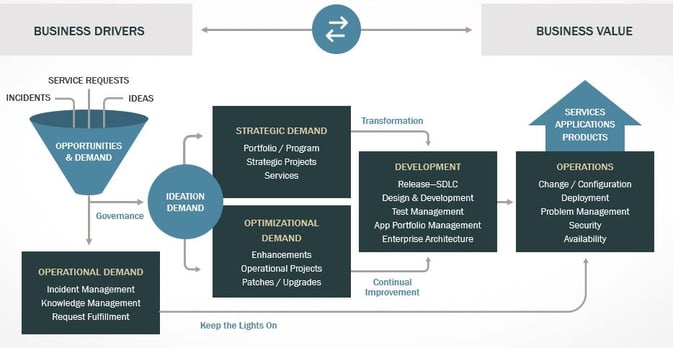
Controls governing requesting services or reporting issues with services are defined within ITSM / ITIL industry practices and governed by the organization's Service Definitions, including scope, costs and commitment levels (SLAs).
Applying appropriate controls over Ideas for new or enhanced services is a little more involved. As reflected in the diagram, Ideas go through our Ideation / Demand process and result in Optimizational Demand (part of our Continual Service Improvement program) OR Strategic Demand (more transformational type initiatives). Based on the size, complexity, cost and risk of the Idea, more or less Governance needs to be in place. We will expand on this later in the article.
Governance in an Agile World
Where do we look for a model for Governance? While ITIL historically represented a slower, more stoic, waterfall approach, ITIL 4 has incorporated newer concepts and ideas. The ITIL 4 Service Value System incorporates 7 Guiding Principles. These Guiding Principles provide a consistent way of thinking in converting Opportunities and Demand on IT into Value for the business. The 7 Guiding Principles translate and align nicely with the Agile Manifesto and the DevOps principles. This consistency enables us to leverage ITIL principles for an effective governance structure AND still be agile and reactive. 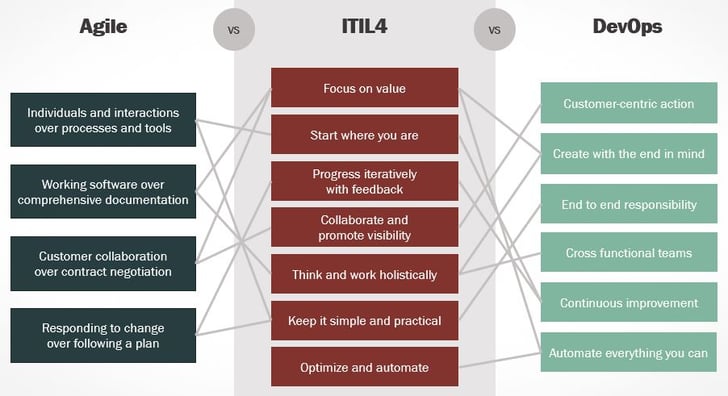
Expanding on the concepts in ITIL, FSA’s IT Governance Framework provides us with a clearer picture of what is involved in Governance. The below adaptation of this framework is predicated on strong leadership by management. As reflected, IT Strategy must be aligned with and fully support the Corporate Strategy, and incorporate digital transformation into the strategy. The framework requires the IT Organization to be established with a structure to deliver the IT Strategy (including IT transformation), the IT Resources to be optimized in relation to the strategy, and Enterprise Architecture that enables the strategy to be fulfilled. In addition, it requires an investment evaluation process to ensure all IT Investments lead to corporate value, and consideration of risks and opportunity costs as part of the strategy development.
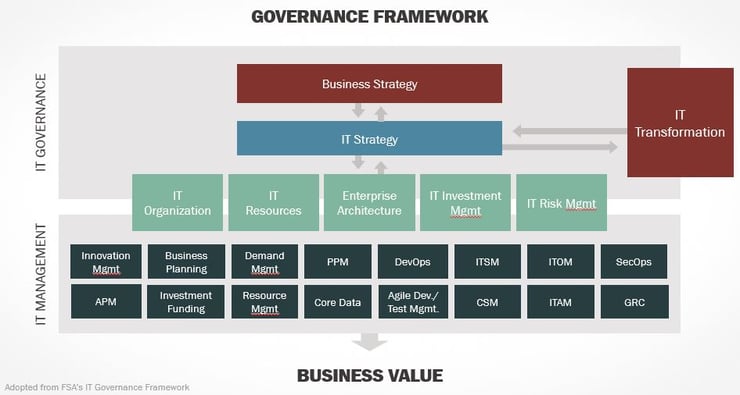 The IT Management portion of this representation reflects how ServiceNow applications help facilitate, enforce, and track compliance with the organizations agreed governance model. For instance, Business Strategy and IT Strategy, along with related Goals, can be identified and recorded through the Business Planning Portal and aligned to Business Capabilities in Application Portfolio Management. These items and data structure are then used in evaluating Demands and aligning Projects.
The IT Management portion of this representation reflects how ServiceNow applications help facilitate, enforce, and track compliance with the organizations agreed governance model. For instance, Business Strategy and IT Strategy, along with related Goals, can be identified and recorded through the Business Planning Portal and aligned to Business Capabilities in Application Portfolio Management. These items and data structure are then used in evaluating Demands and aligning Projects.
A more robust association of this Governance Framework and the strong capabilities of the ServiceNow platform will be explored in future posts.
Now that we have our Governance Framework in place, we can apply it through ServiceNow’s Ideation/Demand process to ensure the right decisions are made with the right-sized level of Governance. The process below represents the key steps in an Ideation/Demand process, where decisions are made quickly based on the size, scope, cost, impact and risk of a new “Idea.” 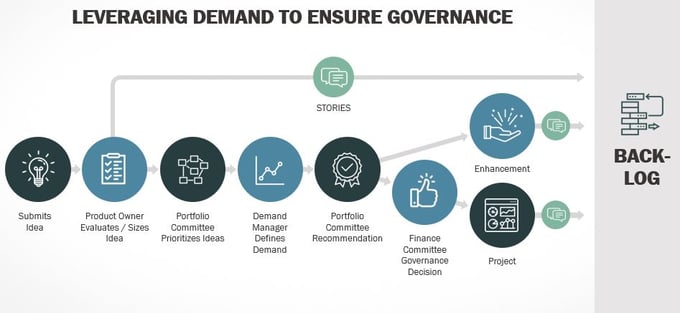
For example, by putting the right controls (e.g., guidance and structure) at the “Product Owner Evaluates / Sizes Idea” step of the process, a quick and safe decision can be made on whether an “Idea” can be decomposed directly to Stories and put on the backlog or if it requires a deeper level of review. Without the proper control structure at this step, all “Ideas” would require a full Governance Review.
Members of both IT and the Business comprise the Portfolio Committee. IT represents the ‘Size’, or projected demand on IT Resources, of Ideas and Demands, and the Technical Aspects of the Solutions. Business members represent the relative priority of the “Idea” in relation to other Ideas in the queue, as well as the impact on the business. By commissioning an effective Portfolio Committee with appropriate roles and responsibilities, we can ensure that all initiatives remain aligned with both Business and IT Strategy, remain consistent with the Enterprise Architecture, and do not exceed the organizations risk posture.
I believe we have made a case for the coexistence of Strategy and Agility within the same environment while supporting and building on each other. Implementing a clear and disciplined Governance practice, enables our organizations to make decisions quickly AND safely. We can provide value to our business quickly AND reliably. We can achieve the BALANCE we require to be an enabler of our organization’s success.
If you’re interested in learning more, sign up for my Webinar at Knowledge ’21. Or if you’re ready to take the next step – and see how Crossfuze can help Strategy and Agility coexist within your organization, reach out at Letstalk@crossfuze.com.
Related Blog Posts
ServiceNow | 3 minute read
ITSM vs. ITIL: What’s the Difference Between ITIL & ITSM?
In the IT world, it’s assumed you understand the difference between the terms ITSM and ITIL. However, not everyone uses these ITSM and ITIL...
ServiceNow | 3 minute read
Get to Pro: 4 Best Practices for the Management of ServiceNow ITSM Pro’s Virtual Agent
Did you know that 69 percent of internal support tickets are solved in just one communication? However, it takes service teams an average of 24 hours...
ServiceNow | 3 minute read
Get to Pro: 4 Key ServiceNow ITSM Pro Features
ITSM ticket volumes have grown an estimated 35 percent in the last year—an unprecedented growth, especially compared to the typical average of just 3...
Subscribe to
Our Blog
Sign up for our newsletter and get insight and information to make your ServiceNow vision a reality with speed, agility, and confidence.





